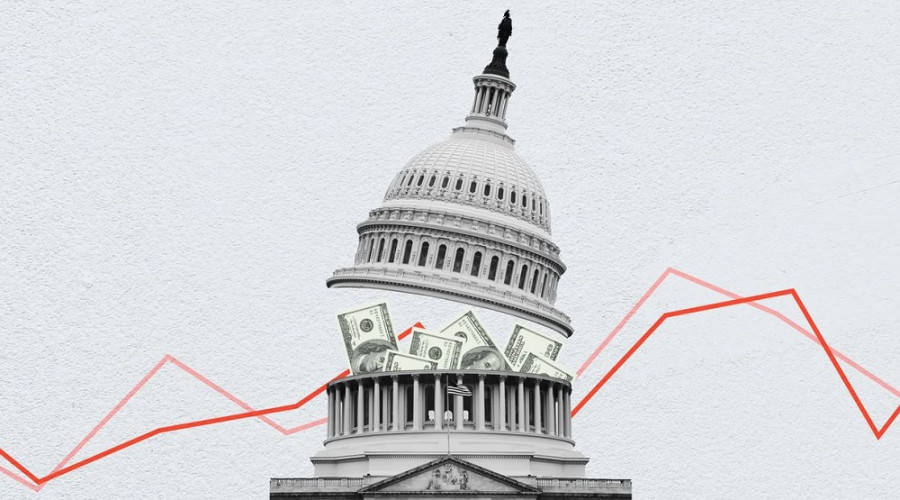For the third consecutive week, EUR/USD has been testing the 1.0500 level, but it continues to struggle to consolidate above this target. A conflicting fundamental backdrop is preventing buyers from establishing an upward trend, while sellers, though not particularly aggressive, are consistently dampening bullish impulses. The 1.0530 resistance level, which corresponds with the upper line of the Bollinger Bands indicator on the daily timeframe, serves as a significant price barrier. Each time the pair approaches this level, price growth slows and eventually retracts back into the 1.04xx zone.
The U.S. dollar is supported by prevailing risk-off sentiment and strong expectations that the Federal Reserve will keep interest rates unchanged at the next two meetings. However, this stance is countered by mixed macroeconomic reports and increasing confidence that the Fed will eventually cut rates in June.
Another fundamental factor also drives the current downward impulse in EUR/USD. The U.S. House of Representatives has approved a budget bill backed by Donald Trump, which includes $4.5 trillion in tax cuts for businesses and individuals over the coming years and $2 trillion in spending reductions. The bill "strongly recommends" that the Congressional Energy and Commerce Committee identify ways to cut federal programs by $880 billion.
The bill barely passed—the Speaker of the House, Mike Johnson, spent hours persuading skeptical Republican lawmakers to support Trump's initiative. Ultimately, it was approved by a slim margin: 217 votes in favor, 215 against (with all Democrats and even one Republican opposing it). However, Trump's tax cut bill has cleared the House and now moves to the Senate, where Republicans hold 53 out of 100 seats.
In response to this close-call decision, the dollar strengthened, and the yield on 10-year Treasuries increased to 4.33%. This reaction makes sense—lower tax burdens increase consumer spending power, which could ultimately drive inflation higher, forcing the Fed to respond accordingly.
However, this is a long-term scenario and cannot sustain dollar bulls over an extended period. While the House approval of tax cuts has provided short-term support for the dollar, this fundamental factor has a limited "shelf life." By Wednesday's U.S. trading session, Treasury yields had already declined, preventing the greenback from finding solid footing.
Overall, EUR/USD remains in a state of uncertainty. Trump's aggressive rhetoric, including threats of additional tariffs, provides background support for the safe-haven dollar. However, recent U.S. macroeconomic reports exert pressure on the greenback. The Conference Board Consumer Confidence Index fell again this month to 98.3, marking its fourth consecutive monthly decline and the weakest reading since June last year. Retail sales data was also disappointing—U.S. retail trade volume fell by 0.9% in January (the worst result since January last year), and excluding auto sales, it dropped by 0.4%.
Against this mixed backdrop, EUR/USD continues fluctuating within a narrow range—buyers cannot establish a foothold above 1.0500, while sellers struggle to push the pair below 1.0400.
However, key economic releases later this week could trigger significant volatility. On Thursday, revised U.S. GDP growth data will be released. The initial estimate showed a 2.3% expansion in Q4 after 3.1% growth in Q3. If the second estimate aligns with the first, EUR/USD's reaction will likely be muted. However, any unexpected revision—whether upward or downward—could prompt a strong response from the dollar.
On Friday, the January Core PCE Price Index will be in focus. It remained at 2.8% YoY in December, slightly above the forecasted dip of 2.7%. The index has been stuck at 2.8% for three consecutive months. The January reading is expected to hold steady at this level, though some estimates suggest a slight decline to 2.6%. The dollar could receive a notable boost if the core index shows even a marginal increase (e.g., 2.9% or higher).
From a technical perspective, the EUR/USD pair is in an uncertain position. On the daily (D1) timeframe, the price remains within the Kumo cloud, situated above the Tenkan-sen and Kijun-sen lines, while fluctuating between the middle and upper lines of the Bollinger Bands indicator. For the bulls to resume upward movement, they need to consolidate above the 1.0550 resistance level, which aligns with both the upper boundary of the Kumo cloud on the D1 timeframe and the upper Bollinger Band. On the other hand, selling opportunities will only become relevant if the price drops below the 1.0440 support level—this coincides with the lower Bollinger Band, as well as the upper boundary of the Kumo cloud on the four-hour timeframe.













